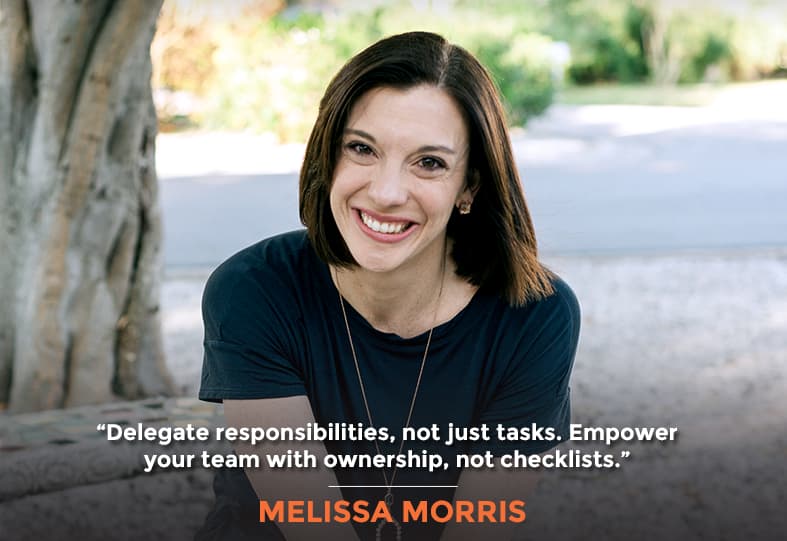Scaling an agency shouldn’t mean sacrificing your sanity or profit margins. Melissa Morris is the founder of Agency Authority, a proven system for scaling without chaos. With over seven years of experience transforming agency operations from the inside out, Melissa helps agency owners reclaim their time, boost capacity, and unlock new revenue.
In our conversation, we discuss how AI is reshaping agency workflows—from creating SOPs in seconds to preparing for strategic meetings. Melissa breaks down the critical difference between delegating tasks and delegating responsibilities, and why that distinction determines whether you stay trapped in the weeds or actually scale. We examine the real culprits behind “scope creep,” and explore how to set client expectations that stick. We discuss contract protections most agencies miss, the power of proactive client check-ins, and why time tracking isn’t the enemy—it’s your pricing compass. Plus, Melissa explains when to fire a client, how to conduct meaningful postmortems, and why building systems as you go beats tackling everything at once. This conversation offers a clear framework for transforming operational chaos into sustainable growth. So without any further ado, on with the show!

In This Episode
- [03:23] – Melissa Morris discusses the use of ChatGPT in improving client onboarding processes and setting client expectations.
- [10:00] – Melissa recommends clear, specific instructions for team members to avoid ambiguity and ensure accountability.
- [17:29] – Melissa suggests solid client onboarding processes to prevent scope creep and ensure clear deliverables.
- [20:40] – Stephan implies using AI tools like ChatGPT to identify issues of profitability and potential solutions.
- [39:10] – Melissa shares an example of a client who returned after a long period, highlighting the importance of retaining digital files.
- [46:01] – Melissa emphasizes the importance of conducting retrospectives to learn from project challenges.
- [52:32] – Melissa advises agency owners to build as they go, addressing needs and problems as they arise.
Melissa, it’s so great to have you on the show.
Thank you so much for having me on. I can’t wait to dig into the conversation we have planned.
Yeah, so first of all, I’d love to hear how AI is changing the conversation and how you work. Are the agencies you work with having to increase efficiency, downsize, or pivot because of this new AI-driven future we’re heading into?
Yeah, a lot of the agency owners I work with are definitely still in the experimental phase, trying to see what’s going to work well for them and how they can best use it. I know a lot of agencies out there are implementing experiments themselves and trying to see how we can use this for productivity. How can we use this to increase ROI? And one of the ways we as a team have been using it, as you mentioned, is that I have the top framework TOPPP. One of those is processes, and we’ve been relying a lot on AI to speed up the creation of things like standard operating procedures, which we found to be particularly helpful.
Yeah. So what would be an example of a use case? Let’s say ChatGPT is developing an SOP or improving an existing SOP.
So we do use ChatGPT, that’s the one that we use most often. And the way we’ve gone about it is, I think what’s important, and you know what everybody’s more and more realizing, is what ChatGPT, or any AI platform, spits out is really only as good as what we’re putting into it.
So when I tell my agency owners, if you’re going to put into ChatGPT or any AI platform a broken workflow filled with inefficiencies, gaps, and redundancies, well, you’ve just now have a quickly documented broken workflow, right? The fact that it’s now somehow documented with pretty bullet points and fancy emojis doesn’t mean your business and team are suddenly a lot more efficient and effective.
So what we’ve been doing is having conversations with our agencies. When we’re working and reviewing a workflow, we anchor it a bit by maybe discussing Client Onboarding. How are we improving retention? How are we doing a better job of setting client expectations? Well, let’s talk about Client Onboarding. So this is an organic conversation that I’m guiding. We’re talking through it, and as I mentioned, I’m keeping an eye out for where we’re seeing gaps. Where are the team’s pain points? Where is the business owner getting pulled in? Okay, now let’s talk through all that, and let’s start to map out something that feels clear, more streamlined.
If you’re going to scale beyond $1M, you have to get out of client delivery. The sustainable path is building a strong, accountable team.
At that point, I can take that transcript, drop it into ChatGPT, and then tell it what to do. “Here’s what I want you to pull out. Here’s how I want this to look. Here’s how I want you to format that.” And it’s spitting it out. So, whereas before, someone on my team had to go through, listen to these conversations, extract, format, and get this stuff together. It’s able to do it in 60 seconds, allowing us to move through iterations and get things rolled out to the team much faster than we had in the past.
Yeah, ChatGPT is changing how we do business. I just listened to an episode of My First Million Podcast. Great show. I really liked that one. And the founder of HubSpot was being interviewed there. And I don’t actually think it was the guest sharing as one of the hosts; he mentioned it before he went into a meeting. He now uses the LLM to brainstorm, strategize, and prepare talking points before attending a meeting with his team.
And you’d think, ‘Well, isn’t that the point of a brainstorming meeting —to brainstorm with your team?” But all this upfront work with ChatGPT, or whatever your LLM is, feels like overkill. A team of choices will markedly improve the output of that meeting. And it’s just like you don’t want to go into a meeting without an agenda. At least Jeff Bezos doesn’t walk out of the meeting without one, having done the prep work using ChatGPT as your conversation partner beforehand. I just thought it was a brilliant insight.
So yeah. Anyway, I don’t want to make this all about AI. So let’s talk about accountability and how to increase the accountability of the agency, its employees, the client, and the overall workability of the whole system.
Yeah, so the framework we’ve mentioned here TOPPP, that T stands for team, and this is a really important piece for laying the groundwork for a business that’s really going to be scalable. Suppose you’re really going to reach a million dollars, beyond that, and truly be serving in that CEO role. In that case, you need to get yourself out of client delivery. The way to do that is through a team, assuming you are a service provider, an agency or a business that offers services to clients, and that can be really tricky, and it starts with hearing, “I’m having a hard time delegating. The team isn’t accountable. I still have to go back and check in things I’m getting pulled back in when I shouldn’t be getting pulled back in.” And these are all red flags to me, indicating a breakdown in the delegation process.
The way I like to think about the delegation process is that, for many, delegating means handing someone a task and then getting that task done. But I want business owners to think about delegation because I want to hand you a responsibility, and you’re going to make sure that responsibility gets taken care of.
Delegation isn’t handing off a task—it’s transferring responsibility. That’s how you build real accountability in an agency.
So, for a super simple example, there’s a big difference between saying, “Hi, Susie Q, I need you to invoice client X, Y and Z on Thursday. Got it?” They’re going to go and do that, versus saying, “Okay, Susie, you are responsible for making sure these clients get invoiced on the last Thursday of every month, following up if payments aren’t getting made, making sure there aren’t any chargebacks, updating our bookkeeper,” right?
You can see there’s a big difference in one I have just delegated a task which still requires me, the person who delegated it, to make sure it’s getting followed through with things are getting done in the way I want them done, and I’m checking that the alternative is now I’ve delegated a responsibility so now this individual can take ownership, because I have equipped them with what they need to make sure that this gets across the finish line and using additional SOPs and checklists and things to make sure it’s getting done correctly. But now I’m really able to offload a responsibility rather than just a random task.
Okay, so let’s say I want someone on my team to be more proactive with AI usage. So in this case, I’m not delegating a task. I’m not saying I want you to watch this training from OpenAI about prompt engineering. I don’t want to direct them to specific YouTube videos and have them take notes and do the exercises and whatever, that’s micromanaging. I want them to have the initiative to learn new platforms as they appear, new techniques, and new prompt craft. They should just come to me with what they discover, and I don’t have to constantly follow up with them. So in that particular scenario. How do we get that happening?
Yeah, and that one does make it a little bit more ambiguous, right? I was coaching an agency owner through this just a couple of weeks ago because this is the type of thing we want to delegate. But then we show up at every team meeting and it’s, “Oh, I didn’t really work on that. Oh, I’m not really sure what’s going on there, and it feels very muddled.”
So my recommendation there is, let’s not just give a high-level, “Hey, go see how AI can support the business,” or “How could we use AI for our marketing?” or whatever. Let’s get really clear first. Let’s think of, “Is there a problem we’re trying to solve?” Yes or no, if there is, okay, cool. Let’s move forward with that. If there’s not, we’re just experimenting. We’re learning.
Here are some things that I would recommend a business owner do. So first, do not say, “Go see how we can use AI to help us with this. Go take a pass at that and let me know what you find.” Do say, “I would like you to spend four or five hours researching how other marketing companies have been using AI. I’d be really curious to see how they’re using it to support their clients’ streamlined billing, and who has been getting any ROI from it. I would like you to find very specific data points, and I want you to capture all of this in a Google Doc. We’re going to meet next Friday to review it together, and then I can follow up with more steps.”

So again, I didn’t just pass off a weird, confusing task. I was very clear about what the expectation was, without having to say, “Go, look at this website. Go watch this training,” right? “Go do this thing.”
Yeah, I think clients actually expect you to be proactive as an agency. When I say “you,” I’m referring to the industry as a whole, which is expected to increase efficiency, boost productivity, and enhance effectiveness through the use of AI. Then they should be charged less or the same amount. They should be getting more output than they got, let’s say, six months ago — more results.
And I’m curious what your take is on that, because there’s a lot of human effort and labor involved. And you know, margins can get eroded. And conversely, if the client doesn’t feel like things are moving faster and faster, they might express concern. The AI advances are evident in the output from the agency. They might move on to the next shiny object agency, and then to the next in the series, trying to find someone proactive enough for them.
Yeah, I think that’s where the agency needs to do a good job of teaching their account managers on how to manage and set expectations for their clients, because that’s when things are going to really run away with you, is when you’re not being clear about expectations and what can be expected. And so I think that means you need to look closely at your own services to understand where you are saving time, what can be done faster, and what still takes extra time.
Set expectations before your client sets them. Once you’re reactive, you look defensive; when you’re proactive, you look intentional—and that builds authority.
So I know that at the agency, we can hear someone say, like, “Oh, well, I’ll have a ChatGPT, write an SOP.” Well, as I already said, it can spit something out. Or if you put in something broken and inefficient to begin with, great, now you just have something really inefficient documented.
So there still needs to be a strategic component, and I think that needs to be worked on before we can produce something of quality. And so I would encourage business owners to do the same. Find where you are bringing the value and then highlight that to your client base. And you need to be setting those expectations at every checkpoint through the process.
Don’t let them come to you first, I guess, is what I’m getting at. We want to be proactive with these conversations, rather than reactive, because once we become reactive, it starts to look like we’re being defensive. We feel caught off guard versus when we’re coming at. It is very proactive. It feels more intentional, and our clients better see the value and see us as an authority.
Yeah, one thing I’ve done proactively for our clients and to our clients is we’ve developed this whole checklist and set of guidelines around AI usage for writing content, whether it’s a blog post or some sort of pillar piece of content or whatever it is, product copy, if we’re using AI to write it. We might inadvertently interject hallucinations into the copy, along with other kinds of factual inaccuracies or issues. Some clients are just dead set on not having AI used at all, while others want us to use it to reduce costs and increase output for the same cost.
So we have a whole set of guidelines, and we have a questionnaire that goes to the client, asking, “Tell us which of these options you feel comfortable with.” Using AI for what you want us, using AI for brainstorming, headlines, first drafts, correcting grammar and spelling errors and whatever else, other kind of light edits at the end, tick the boxes, and then our team, our writing team, knows what that client’s what the guardrails are with that particular client.
And I don’t know if other agencies are doing that. Still, it just occurred to me, this was, I don’t know, well over a year ago, that this needed to happen, because most people are not disclosing the amount of AI usage in the creation of content anymore, and so I’m just wanting to put this out up front, and it’s very well received. I think it’s a very proactive thing to do. I think it’s a great example of how to be proactive with a client in this AI era. So I’m just curious, is that something that you’ve heard other agencies doing, or is that kind of unusual?
No, I have heard other agencies doing it, and I’m glad you brought that up because, on the one hand, we could have clients feeling like we’ll just use AI to make things go faster and faster, right? Get more done with less money, but then we could have, on the other hand, clients feeling a bit like we’re cheating or that we’re not going to offer as high a quality of work. We’re going to rely too heavily on something like AI to do the work we should be doing, which will actually result in a diluted output.
Be transparent with clients about how you will—and won’t—use AI. In this new era of content creation, clarity is essential.
So I think one is recognizing where you fall in this, and then being really open and transparent, like you said, with clients, letting them know how you’re going to use AI and how you’re not going to use it. I think that’s just really valuable, especially when we’re talking about things like any sort of content creation or anything in that sense. I think it’s even more important, as you mentioned.
Yeah, another thing I know is an issue you see with your clients, and it’s just endemic in the agency world, is scope creep and the erosion of profit because you feel so pressured to say yes to all these client requests. And it’s not on the road map, it’s not on the statement of work, and they expect that anyway, without any reduction of other kinds of activities, and so then that erodes your profit margins. So what are the solutions to that scenario?
I think that comes back to really solid onboarding, Client Onboarding. I think about what to say when you’re in a conversation with a prospective client. They’re in a different mindset when they’re still “shopping around.” They may be having a call with you or reviewing a couple of proposals, so I think they know what they want and what they’re looking for, but many details are still being cleared up for them at this moment.
And so when they make a selection, that’s the point in time when we really want to revisit those details. So I always recommend that during onboarding, a welcome email revisit these points, depending on the scope, depth, and complexity of the project. Here are the key bullet points. Here’s what we’re going to go over, or even potentially a kickoff call with a client where we’re just stating out loud, “Here are our objectives, and this is what we’re looking to accomplish. Does that still sound right? Okay, cool.” And what that does is when we are very clear about that in that moment. We aren’t assuming they read that little line item somewhere in the contract or remembered from the sales call five weeks ago that we don’t do AX graphics. Still, we will do these graphics, getting that back front and center again, usually starts to eliminate a lot of the scope creep that I typically see.
The other major factor that will greatly benefit your agency and business in reducing scope creep is ensuring that your team members have clear deliverables. So sometimes we’re really clear with the client, but where we’re making missteps is with our team members. Our workflows are a bit messy, and our processes are somewhat unclear. They have direction as a deliverable to provide updates to X, Y, and Z.
Scope creep usually starts during onboarding, so clarity at the beginning protects profitability later.
Well, I could spend an hour doing updates. I could spend five hours doing updates. Providing more context about how much time is allocated to these deliverables and what they really mean will go a long way. Sometimes, it’s not your clients stepping out of scope; it’s your team members.
Are you a proponent of providing a monthly time breakdown that shows how much time was spent on the audit, a strategy document, or whatever? Is that something that you should kind of keep close to the chest or convey to the client?
I think the client doesn’t need to know it took me X number of hours to do X, Y, and Z. The client needs to know this is your deliverable, when I’m going to get it to you, and how much it costs.
Your team, on the other hand, should have better visibility of what you’re going to put together for marketing. Well, how much time do I spend on a marketing grief? Do I spend 10 hours or 100 hours on a marketing brief? There could be a huge difference, and it might even vary based on the package purchased for a particular project or client. But you need to give them a line of sight on that, even if it’s a range. But I think, in my opinion, it’s less important that the client knows that, because then I do think you’re opening the door for saying, “Well, why is it going to take 15 hours? Can’t you put it in ChatGPT and cut that in half?”
Right? Yeah. And what about open book management, where the team is informed about things like profitability, other hard costs, overhead, and so forth. Is that something that you espouse or recommend, or is that pretty dangerous?
I think this is a situation where we’re considering context and a high-level point of view, versus getting down in the weeds and giving all team members a bunch of details. Now you may have a COO who’s tightly looped in on profitability or a CFO who is involved in financial matters. Obviously, these types of individuals are getting down in the nitty-gritty of profitability and details. Still, I think team-wide, what we can be offering them is insight that says, “We are routinely going over the anticipated hours for this type of work. Let’s, as a team, talk about why that might be happening. Here’s what I’m seeing. Can you offer insight? Do we have training gaps? Is the market changing, and do we need to adjust? Have costs just really gone up, and we need to take a look at that.”
But I think just opening their eyes to, “Hey guys, this is taking a lot longer than expected. Let’s have a conversation about why that is, where value comes from,” instead of saying, “I budgeted 40 hours and you guys spent 62,” which feels less important in that context. And then, you know, to your point, we’re not opening the door for people to panic or feel like they’re “getting in trouble or now pointing fingers.”

And then, of course, we certainly don’t want to show up as the business owner with doom and gloom, like, “Oh, our last three projects had razor-thin profit margins,” right? We don’t need to scare people or make them worried about their job, but we do need to address issues within our scope of work and what’s happening in the business so that we can course-correct them.
Yeah, I would imagine there’s a place for ChatGPT or whatever LLM to help identify profitability misses and find potential solutions. You just rattled off some great ideas in there. In a hypothetical conversation with your team, you could probably get a lot of that from ChatGPT.
Yeah, I think you can. Again, you just want to be careful, because when I’m working with a team, you know the adage: there are three sides to every story —his, hers, and the truth, right? So I think sometimes, if you’re going into that with a silo, and especially if you’re the business owner, or maybe you’re a little more removed from the client delivery, to just input your observations and ask for recommendations, and then back out, I think it’s valuable and serves a place.
But I think it’s important to get the boots on the ground, gather their input, and hear their insights and what they’re seeing. Now, what we’re gonna do is take all of those conversations and thoughts, put them in ChatGPT or your platform of choice, and say, “Synthesize this for me.” Pull out where we’re seeing trends. Tell me how this is matching up. What other ideas and ways can we work to improve this? But I do think it’s important to have the people actually involved when we’re getting their insight as well.
Your client doesn’t need to know how many hours it took; they need the deliverable, the deadline, and the value.
Yeah, one of my favorite kinds of prompt tricks is to ask ChatGPT and part of a conversation like, “What are my blind spots? What am I not seeing?” And you’ll get some incredible insights from that. I’m curious if you have any ninja tricks like that as well.
I do the same. I don’t phrase it in that way, but I always say, “What am I missing? What would you add? What’s missing from this?” And I intentionally ask it, “poke some holes in this and tell me what I haven’t thought of or what I should be thinking of.” So that question gets raised a little differently depending on what I’m working on, but that’s always when I’ve gotten something to a point where I feel like I like it and want to use it. That’s one of my last questions: What am I missing?
Yeah, so when you’re working with an agency, right? Let’s say you’re pitching an agency, what are you pitching them? Is it a retainer-based engagement? Is it a project? Are you coming in to solve a particular type of problem, like profitability, morale, or attrition of staff or clients? Tell me how your process works for getting a prospect to want to say, Yes.
Yeah. So we actually have two ways in which we work with businesses and agency owners. Some are project and problem-focused. As you said, client retention is really down. How do we improve this? Okay? Well, let’s look at these different checkpoints. And this would be a time-bound project where we’re going to come in and fix something very specific that needs to be addressed.
We also work with growing multi-six-figure agency owners on an ongoing basis, in a sort of fractional COO role. So this often touches on many different parts of their process, and that’s where the top framework comes in. We’re going to look at their team. We’re going to look at their offers. We’re going to look at their pipeline, which I consider to be your previous, current, and future clients. We’re going to look at their processes, and then the final P stands for profit, like, are we profitable? Where do we have opportunities to improve profitability? And that’s where some capacity training and that sort of work comes into play.
Yeah. Could we dive into one of those keys and provide examples of things that would improve our listeners or viewers, whether they’re an agency or not, and help them become better and more future-proof for these interesting times we’re entering?
Yeah, I like to focus a lot on offers, which often surprises people. Much of the work we do is very operations-heavy, so we’re already thinking about tools, processes, and documentation. But I’ve got that O in there for offers, because that is a foundational piece.
Productizing your services isn’t turning your work into a widget—it’s building flexible modules that deliver efficiency and customization.
If you are not clear on what your offers are, the value they bring, how you’re going to communicate with your client, and how your team is going to execute on it, you may face challenges. The rest is a fool’s errand. There’s no sense in trying to create an SOP for a service offering that changes every single time you sell it. So offers are where I really recommend people start to take a hard look at what they’re doing. It’s about clarifying where we can work towards standardizing and achieving the gold standard of a productized service offering. I know that can start to turn people away and make them feel uncomfortable.
Well, I don’t want to be like I’m just selling a widget, and I don’t think it has to look that way. I work with a lot of clients, and their product size and service offerings start to resemble module service offerings, right? Like we as an agency, know we can support and help businesses with these eight different modules, but how I piece and put those together, and which of those modules I sell to a client can shift and change, which allows for flexibility and allows for a business owner to create what feels like very custom offers to their clients without lacking now in standards. You know the efficiency benefits that come from having standardized things.
Can you share an example of a client you overhauled in the offer area?
Yeah, I actually have a really great example. We did a LinkedIn live earlier in the summer, so if anybody wants to check it out, we talked in even more detail about what it looked like. But towards the end of last year, I was working with a woman who supported nonprofits in fundraising. Her top-tier offer was quite expensive and hands-on. We were thinking about it in a modular way, considering how we could build these pieces. And then, where can we work to streamline?
Well, we all know that when January of 2025 came, there was massive upheaval in the nonprofit world. Suddenly, the premium service offering she had been developing for the last couple of months, which we’d been working to standardize, just wasn’t going to work anymore. But what we did is that work allowed us to now break apart the modules and say, “Okay, instead of having this package encompass these full eight suite modules. We’re going to break it into phases, and we’re going to just have these couple, and we’re going to streamline this and have just these couple.” And so we spent about a month reworking that, pulling pieces apart and moving them around to create a new offer. And within a week of putting it out there, she sold three.
Cool, yeah, it reminds me of years ago when I used to only offer a full, comprehensive SEO audit, but that’s like three audits in one. Essentially, it’s a technical audit, a content audit, and a link audit. Yeah, I decided I should offer those as separate audits as well. If I offer the bundle at a lower price, it feels like they’re getting a deal, even though I didn’t reduce the price of my full, comprehensive audit. I charged more for the individual à la Carte pieces. So that was a pretty cool innovation. So what you’re describing reminded me of that.
We don't need to scare people or make them worried about their job, but we do need to address issues within our scope of work and what's happening in the business so that we can course-correct them. Share on XYeah, and that’s exactly it. So then, now, you might have lost sales when someone came on and thought, “Well, I don’t need the comprehensive package. However, I really want that piece of it.” so you still have these key pieces that are standardized, and there are SOPs. There are lots of good templates and such in place, but when we stack them on top of each other, we can create a really customized and comprehensive package for clients based on their specific needs.
Yeah. So how do you come up with the price? Typically, in the agency world, you have an engagement or a monthly retainer. Is that the right way to do it, or is there a better way? And what would be a better way? If there is? Because I know my agency charges a retainer, and occasionally we’ll take on one-off projects, but it’s a pain. That’s not something I’m really that keen on. I don’t want somebody to come and then turn around and leave as soon as the project is finished. I want a long-term relationship.
One client, for example, is whatismyIPaddress.com. They’ve been with us since 2017, and that’s the kind of client I want. Obviously, any agency would want. But you know, we also delivered massive value. When he came to us, it was 2 million unique visits a month, and we’re now at 13 million. We’re holding steady without a loss in traffic, while a lot of folks are getting decimated with AI overviews and zero-click searches. He’s not seeing that downtrend and clicks that a lot of folks are seeing. So anyways, yeah, just curious to hear what you have to say about that.
So I think, whenever possible, moving into that retainer style offer is key, because, like you said, “it creates a lot of predictability for yourself and for your client, and it creates the opportunity to continue to serve a client for a very, very long time.” Now, with that being said, retainers can really backfire, especially when the pricing is not based on data points. I am a big fan of time tracking, and I know everyone shudders when I mention it, but you can’t have well-informed packages and pricing without something to refer to or pull from, so you have to look back at your data. You have to look back at time tracking. You have to look at your expenses, and that will guide you toward a price point.
Retainer offers create predictability for you and your client—but they only work when pricing is backed by data.
And then this is where I hear my agency owner say, “But my clients will never pay that. Melissa.” Okay, then you need to change the scope of the project or the client. And I know that might sound harsh, but this idea that you’re going to deliver $10,000 worth of work and you’re just going to charge your client $5,000 because that’s all they’re going to pay. You’re never going to have a profitable business, and you’ll keep struggling to improve profitability and move in the right direction. So you need to align.
You either need to look at your service offerings and see, “Where can I tighten scope? Where can I create efficiencies? Maybe I can lean on AI somewhere. Where can I automate something? Are there pieces I can strip out?” You need to take a hard look at that and see where I can get the cost down. You need to recognize that your business may have outgrown the previous ideal client and focus on a different set of ideal clients.
The point is that your pricing must reflect the true cost of work and time to ensure good profit margins and room for growth.
Yeah. So what’s a profit margin that is reasonable or typical when you work with a number of agencies? So what are you seeing?
So that’s a tougher one to answer, because that can be a big spread that depends a lot on the size of the team, the type of overhead a business has, so that I don’t even think I could give a useful range, because that’s going to vary a lot, particularly based on size of business and expenses that businesses have.
Let’s kind of get a range, like, are we talking about 20% margins to 60% or 80% margins?
Yeah. I mean, really, really rough ballpark. I think for bigger businesses, 15 to 20% is a good profit margin to aim for. Now, a smaller business with fewer team members should have a higher rate, especially if the business owner is still down in the weeds with client work. So I would say, yeah, especially in the multi-60 figure range, at least 15 or 20% potentially a lot more.
So what are some of the biggest mistakes that you’re seeing on the client side in terms of working with agencies? What are the things that are costing relationships, burning bridges, and misfiring with the outcome that everybody wanted for whatever the engagement was?
Yeah, I know what will always impact client experience is poor communication. So I’m definitely a big fan of that. Saying even no update is still an update. You really want to create a good communication rhythm with your clients. Sometimes I’m meeting with business owners and asking them, even with retainer clients, how often they meet with their clients.

Well, you know, the work we do really doesn’t mean we have to meet. So if we’ve got something to talk about, I’ll shoot them an email, they know, or I’ll hear about it too. They know they can always reach out to me if they need me. And I do want to put it out there. I’m not a big fan of wasting everybody’s time, right? I don’t think we need to have a standing weekly meeting for everybody to look at each other. With that being said, even if you have a business that doesn’t require tons of input from your client and things are feeling really status quo, I recommend at least a monthly check-in with them. Let’s get some face time, particularly in this virtual world, because it is really easy for you to just grow farther and farther and farther and farther apart.
And where, you know, those first couple of months, it’s like, “Oh yeah, we don’t need you. We’re good.” Then a few more months go by, “Oh no, we’re okay.” And then the next thing you know, they’re thinking, “I’m paying this person all this money, and I don’t remember the last time I heard from them, or the last time I talked to them,” and they’re looking at their own profitability and thinking, “Oh, we’ve got to cut expenses. Where can we go? We haven’t even talked to them in six months. What are they doing for us?”
Suddenly, what felt like a really solid relationship dilutes very quickly when, like you had mentioned to me, a shiny object pops out, “Oh, can’t AI just do that for you?” Or someone mentions, you know, “Oh, I get that same service for way less,” all of a sudden, you know what I mean, and it’s hard to go back. So I think continuing the client relationship through some face time is really, really important.
And then in the in between, can we shoot them a random email? Can we do a random check-in? So I was working with a company. They secure podcast interviews for their clients, and there is a lull when they first start working, without the pitches, follow-ups, and feedback, right? Like, there’s this kind of lull that’s just natural to the way they work, and we’ve built in an opportunity where that’s the moment that they check in with the client and they give them an update, even if it just says, We just want you to know we’ve got a bunch of outstanding pitches for you.
We’re working hard on follow-ups. We’re expecting to get some of those yeses any day. Now we’re going to check back with you when we do that. It feels a lot better than when the client has to reach out to you and says, “Um, my pitches.” Is anybody going to get me on a podcast? It just feels a lot better when, again, this comes back. We talked about this a little bit before. Are we being proactive with our conversations, or are we being reactive?
Retainers only work if pricing is based on real data, not hope or habit. Share on XNow, what if the client is not really cooperative? What if the client is so busy? I’ve had clients like this, where they ghost you, they disappear for weeks at a time. You keep needing responses from them for things going live or things getting completed, and they’re nowhere to be found. And it’s like you can pester them, but it actually doesn’t work. Yeah, that’s not a good client, obviously. And I fired clients like that. But is there another way besides firing the client when they’re just too busy to give you any face time or even respond, like with a text or email?
That’s a great question, and we’ve definitely seen that happen. And I think to your point, there’s a moment where you have to ask yourself, “Is this a good client?”, and if their inability to show up is going to truly impact the work that you can deliver and the quality that you can deliver, it may be a moment where you have to say, “this is just no longer in alignment”. With that being said, we don’t want to run around and fire every client who doesn’t answer emails or is too busy for a phone call or Zoom meeting.
So, a couple of things I like to do. I recommend that business owners include a clause in their contract to provide some protection during a moment of ghosting. Sometimes this could look like I have an example. I was working with a branding and website company, and they offered a slot for this company to have their website built within two months, right? Like their client, they’ve allocated this time, and inevitably, the copy would be a mess. They weren’t approving things. They were too busy to get on a call and walk through the site map. As a result, the website that was supposed to launch on September 1 isn’t even halfway done by then, but they’ve accounted for that in their capacity.
They’ve got another website coming on to work on this one, which was supposed to be done. And so what we built into the contract was a clause that said, “if you are not needing these benchmarks, then your project goes on hold, and when you are ready, you let us know, we will work you back into our workflow. And then there is a fee associated with getting you worked back into the workflow. So, okay, you had a busy season. Stuff got away from you, whatever. That’s fine. But then now we’re not expected to continue to work on your website, when now we have two more that are coming on because yours was supposed to be done.”
Your pricing must reflect the true cost of the work and time to ensure healthy margins and room for growth.
So, work into your contract and scope areas where you can protect yourself a little bit for those instances. And then ultimately, I’ll share something with the VP of the agency I worked at years and years and years ago, when I was still working in the agency, she would always tell me, she’d say, more. So you can’t care more than the client. It’s true. You can only ask them so many times. You can only get their approval. You know, beg for their approval if they don’t care, then okay, but make sure your contract protects you when they don’t care. Yeah.
What are some other contract protections that are not that common, or maybe kind of gaps in people’s knowledge or coverage?
That’s a good question. So, other ones you want to include, especially if we’re thinking in that marketing sphere, are who owns the files? How long are you obligated to retain files? It’s actually the same agency that I’m thinking of. They don’t all the time, but it seems like at least once a year, we would have a client return from two or three years prior and say, “Hey, do you still have that flyer you designed two years ago? We need that artwork so we can get more printed.”
And it’s like, I should not be expected to hold on to that artwork or that file. So I think any clause in there about digital files, data, that sort of thing, how long you’re expected to hold on to it? Can they come back and ask for it later? Is there a fee associated with that? That’s something I think is important and can often get missed.
ChatGPT is a pretty good lawyer. It seems like these days, just feed your contract to ChatGPT and ask, “Where are the blind spots, or where are the gaps?” And a lot of times, you can get some really good feedback from it. Is that part of your process to use ChatGPT for analyzing contracts?
No, I don’t. So I mean, we have a standard contract we use with agency owners, and if one gets sent to me, I have my attorney review it, especially if it feels like a heavy one.
But, like, for the agency you’re working with and advising them to improve their contract, how do you get them to improve that contract? Are you telling them to hire a lawyer? Are you giving them specific clauses to add to the contract? How does that work?
No, I say, hands off on that. I’m not getting tangled up in anybody’s contract. So I always tell them that I will make recommendations on items that they should add or ways to improve their contract. Again, based on what I see, I can think of clauses and such that need to be added, and I may offer recommendations on how I’ve seen other companies or agencies write or word it. Still, I always defer and say that, at the end of the day, they should consult with their attorney to ensure it fits their state, business size, and all those good things.
Being proactive with clients makes you look intentional—not defensive or reactive. Even 'no update' is still an update. Don’t let silence erode your client relationships. Share on XYeah, one mistake I see companies make is being overly protective and draconian in their contracts, especially when they’re the vendor. It’s like, I’m not finding that. It was so one-sided. All the indemnifications and everything are for you and nothing for me. Like, that’s not a partnership. And then I’ve passed on using vendors because of that. Yeah, so I’m curious about your thoughts on that.
Yeah, I like to use my judgment on that one, I will say, personally, I had someone, this was a few years ago, give a lot of pushback on agency, authorities, contract and agreement, and I had to take a moment and think back, okay, of all the people who have signed this in all the years we’ve used this as our standard contract, this is the one individual who feels compelled to red line it to death.
That was such a red flag for me. I just said, “we’re not going to work together with somebody who had that many issues” and they wanted to remove all of my protection and add in all of their protection to the point where I’m like, “This isn’t my contract anymore. You have just manipulated this into some version of what you want me to sign”, and so I bowed out of that. But yeah, I think, like you, there have been times when someone sends me a long list of contracts, and it feels overwhelming, so I don’t sign. So I think that’s up to every individual and their comfort level —what feels good for them. If you need to consult with an attorney, do so, and then only do what feels good to you.
Yeah, has there been a time in your entrepreneurship journey that you felt like maybe I should have done something different, or you never, ever had any kind of existential crisis or regrets?
Yeah, I’m thinking of a project I worked on. It’s been a few years at this point, and it was a sticky situation. In retrospect, I definitely could have handled it better, and what we were dealing with was that I was having a lot of conversations. Stations with the business owner, and there was a particular team member who we later found out was not a good team member, and they were, in several ways, they were not a good team member, and at the risk of sounding dramatic, was quite blatantly sabotaging the work that we were doing.
And it was one of those things where it was so little step, little step right, like, little push, little move, little move, that it wasn’t until we had what now felt like a big sabotage moment that I could look back and say, “Oh, I see how this whole project was slowly moving off the rails because of this team member, just slightly moving it a little bit, Larry, just moving that steering wheel just a couple degrees, just a couple degrees”, until all of a sudden, we were really off course, and I beat myself up about it. I had to be honest for a few months, because I thought I should know better, right? I have managed clients for decades. At this point, I know how this works. I’ve dealt with good clients, bad clients, and everything in between. And I thought, “Melissa, how did you miss this? How did you miss this?”
So, I recommended this to all business owners. We’ve all been there. We’ve all had the project that went way off course, went way over budget, and went way over timeline. And I always tell my business owners, “okay, it’s okay. Everybody has these moments, but now we need to do a retrospective and see how we can make sure this doesn’t happen again.” And that’s what I did with my team. How do we make sure this doesn’t happen again? What checkpoints do we need to put in? Is it a survey? Is it a team check-in? Is it a consultation with the business owner? How do we make sure?
Run post-mortems on the projects that went wrong—and the ones that went right. Both teach you what to repeat or improve.
And so, starting then until now, anytime we are halfway through a project or an initial engagement, we have a check-in call with a business owner, and I am asking them, “What does the team’s buying look like? How’s everybody feeling? What’s going on? Are we still on track? Where can we course correct?” Because then I’m catching it before we’re way off course, and it’s worked great.
Yeah. Well, even if it did go way off course and ended with the client terminating the contract, there’s still an opportunity to learn and grow from it. If you have a post-mortem, really dig into what the learnings were here. What could we do better? Instead of just saying, “Well, chalk it up as a loss here and move on. Dust yourself up, pick yourself up and move on,” you didn’t learn what you were meant to learn from it.
Yeah, that’s exactly right, and I’m glad you brought up post-mortems, because I recommend all my business owners do that, and I recommend they do it with two projects, the ones that everybody was like, “Oh, I’m so glad that’s over. Why did that project feel so hard? It went way over budget, all the things.” I also want you to look at the projects that went off without a hitch, felt perfect, and went under budget.
Everybody knew what was going on. It was just vibing, and it felt amazing. Look at those two because you want to do that again. So yes, we want to learn from what didn’t go well, but we can also learn from what did go well and say, “What did we do that made this go off so well? Well, let’s implement that for all of our projects.”
Right? And here’s another opportunity to get ChatGPT to chime in and ask for best practices, checklists, and ideas for your post-mortem meetup or whatever.
Absolutely.
I know we’re getting close to time here. I just want to share one and get your feedback on this one. When you were talking about that saboteur and the whole scenario and how it played out, it reminded me of a particular engagement with a client where we were brought in. It was a sizable project or engagement. It wasn’t just a project; it was an engagement. We were the SEO team for this company, and then two weeks later, we found out that a new internal SEO guy had just been hired, which is weird.
And it turns out that he was not our friend. He was not on our side; his interests and ours were not aligned. He saw how much we were getting paid, and he was making a fraction of that, obviously, and there were some sour grapes there. And the engagement got further and further off track. He stymied things and kind of thwarted us for quite a while, until it got very uncomfortable about eight or nine months in, and I realized I had to fire the client.
I’m so glad that I went straight to the client to say that this isn’t working out. And I proactively said, “We’ll give you some time to wrap things up. Here’s the timeline we’re looking at.” And he was surprised. And we had a conversation. He wanted to get on the phone right away. The surprising thing that happened was that he increased the size of our engagement, and then he sidelined. He didn’t fire the guy. I said, “Please don’t fire him. I don’t want to get people losing their livelihood, but the workability isn’t here, and this is why.”
So essentially, this guy started reporting to us with a dotted line report. And the turning point I found with this is, funny enough. It wasn’t like some sort of business hack or whatever. I was guided to pray for the guy, the saboteur in the company that was our thorn in our heel, was actually somebody who, when you think about the spiritual lessons of all this stuff, business is a spiritual game.
So I pray for the guy, because I’m like, “Okay, this isn’t personal. It may feel personal, but the Four Agreements don’t take anything personally.” I believe in that, so I prayed for the guy. Shortly after, things unfolded in a way that gave us significantly more scope and budget to work with. And, yeah, that was pretty awesome.
Oh, that’s a great story. And I think it’s such a good reminder, too. Just remember that we’re all people, right? Just moving around, trying to do our best. And I talk about this all the time, but just be clear. Be clear. And if you are showing up with open communication and willing to be a good listener, right? So you were recognizing a problem, you’re presenting this problem, and the conversation is happening. There is no bad feeling toward this individual, just a recognition that this is not going to work out. And I feel like, you know, in the example I shared, everybody was really clear, and it resulted in a positive outcome. I think just showing up with clarity and a bit of empathy always goes a long way.
Yeah, for sure. So I know we’re out of time, but one last wisdom nugget for our listener reviewer before we wrap up.
Yeah, I would just say I want to encourage all of my agency owners to build as you go. I think sometimes this idea of aligning your offers and productizing service offerings is important, and do you have clear accountability for your team? And what are SOPs? I think sometimes agency owners can step back, and business owners can say, “Oh, now I have this mountain of a project that I need to tackle and that I need to work on.”
And my advice is always to build as you go, identifying a need and a problem. Let’s sit down and address it. And that’s suddenly the challenge that you’re going to work on for that week, month, quarter, whatever, and then get that figured out, and then move on to the next one.
Awesome. Well, Melissa, this was a pleasure, and thank you for sharing all this advice and experience with our listeners. If they want to work with you and increase their agency, make it more efficient, more profitable. How do they find you? If someone wants to learn from you and you have a blog or podcast, where should we send them?
Yeah. So if you want to learn more about agency authority and how we support business owners, you can visit youragencyauthority.com. I also do a lot of LinkedIn Lives, where I host training and bring in collaborators to share information. We’ve got some previous client stories on there, and you can learn from other agency owners and hear about their experience. And sometimes it’s helpful to hear about the roadblocks others have moved through and what it’s like to get on the other side. So even if you just want to learn more. Connect with me on LinkedIn. I’m Melissa V Morris. Like I said, there are tons of videos and stuff there too that you can learn from at Markham, awesome.
Thank you, Melissa and thank you, listener. Go out there and make the world a better place. We’ll catch you on the next episode. I’m your host. Stephan Spencer, signing off, you.
Important Links
Connect with Melissa Morris
Apps/Tools
Business/Organization
People
Previous Marketing Speak Episodes
Your Checklist of Actions to Take










About Melissa Morris
 Melissa Morris is the founder of Agency Authority, a project management and operations consultancy for agency owners. Melissa uses her 10 years of agency experience to help business owners maximize their team, increase productivity, and grow profits. Firmly committed to breaking the long hours and bad pay stigma that plagues the agency world, Melissa and her team help business owners and their teams do the work they love without sacrificing client satisfaction, the bottom line, or their own sanity.
Melissa Morris is the founder of Agency Authority, a project management and operations consultancy for agency owners. Melissa uses her 10 years of agency experience to help business owners maximize their team, increase productivity, and grow profits. Firmly committed to breaking the long hours and bad pay stigma that plagues the agency world, Melissa and her team help business owners and their teams do the work they love without sacrificing client satisfaction, the bottom line, or their own sanity.






Leave a Reply